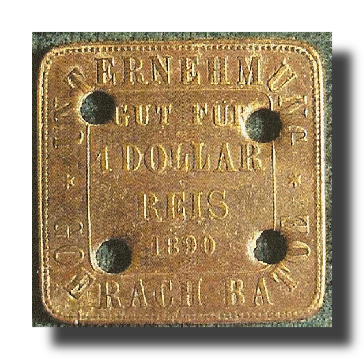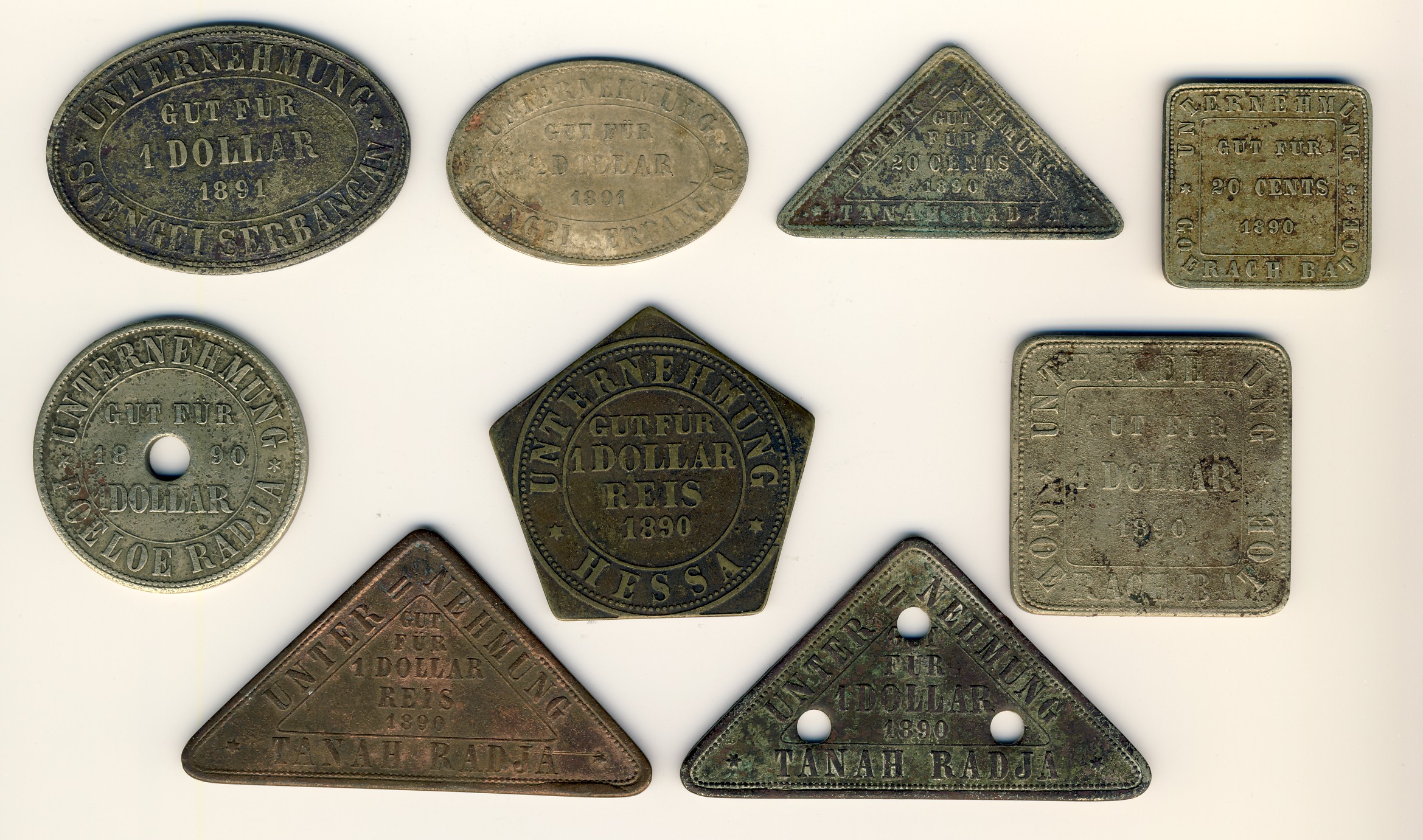
Home en contactPlantation Tokens English IntroductionInformatie gezochtHet ontstaan van plantagegeldNederlands IndieBrits Noord BorneoCeylonOverig AzieAfrikaZuid AmerikaMidden AmerikaBewerkt plantagegeldVals plantagegeldEcht versus ValsGezocht en aangebodenLiteratuur en websites
Welkom op deze plantagegeld site!
For a short English introduction please see the end of this section and the page: 'Plantation Tokens English Introduction'.

Mijn hobby
Als jongen van 10 begon ik met het sparen van wereldmunten. Door een aantal reizen in Indonesië raakte ik geďnteresseerd in de geschiedenis van het land en ging ik me meer specialiseren in het verzamelen van munten van Indonesië/Nederlands Indië.
In de zomer van 2006 kwam ik een aantal aparte ‘Indische’ munten tegen op ebay en ik wist ze op de kop te tikken. Het bleken plantagemunten te zijn en voor mij de start van een nieuw verzamelgebied!
Doel van de site
Hoofddoel van deze site is het geven van meer informatie over plantagegeld in het algemeen de uitgegeven tokens in het bijzonder. Hiervoor zullen er zoveel mogelijk foto’s en afbeeldingen van plantage tokens opgenomen worden. Dit betreft tokens uit mijn eigen verzameling maar vooral ook veel afbeeldingen van internet (bijvoorbeeld van veilingen) en ook foto’s van andere verzamelaars van plantagegeld.
Het is niet mogelijk een volledig overzicht van al het plantagegeld te geven, er zijn circa 850 tokens uitgebracht in (Nederlands Indie/Brits Borneo), en veel daarvan zijn zo zeldzaam dat ze nog niet eens gelokaliseerd zijn en er dus ook geen foto’s van gemaakt zijn. Veel is dus afhankelijk van de bereidwilligheid van andere verzamelaars om foto’s van hun stukken beschikbaar te stellen.
De site zal dus nooit afkomen en een volledig overzicht is dus een utopie, maar het kan wel een goed referentiekader bieden m.b.t. het onderscheiden van echte plantage tokens en vervalsingen.
Een speciaal woord van dank wil ik uitspreken naar Ad Lansen, hij heeft mij geďntroduceerd in de wereld van plantagegeld en me geholpen een goed zicht te krijgen op het onderscheiden van echte en valse tokens.
Daarnaast stel ik het erg op prijs dat ik voor deze site zo uitgebreid mag putten uit de informatie van zijn boek (bijvoorbeeld voor de korte beschrijvingen van de plantages). Voor nadere omschrijving van de plantages (eigenaren, wanneer ze in productie waren), overzicht van alle uitgegeven plantage tokens, alsmede een indicatie van de waarde van de tokens verwijs ik naar zijn boek: "Plantage-, Handels- en Mijngeld van Nederlands-Indië" verkrijgbaar bij www.mevius.nl.
Ik wens u veel leesplezier toe!
Als u vragen/opmerkingen/aanvullingen heeft met betrekking tot deze site of plantagegeld heeft dat u wilt verkopen dan kunt u contact opnemen via plantagegeld@hotmail.com
Met vriendelijke groet, Koen
Introduction plantation tokens of the Netherlands East Indies
This short introduction was made by Ad lansen, I'm glad I may use it for my site.
Token- or plantation money in substitution for normal circulation coins on culture- and estate plantations in North- and South America and Asia are a well known appearance.
The English introduced , end of the 1700’s, in West-India plantation money.
That was , also for payment of the workers on the coffee plantations on Ceylon in the period 1820 till 1890.
From , about 1870 till 1914, these “house tokens” were also used in South-India on the tea-, rubber- and coffee plantations. Around 1900 plantation tokens circulated also on coffee plantations in Mid-America.
From, about 1870, on the , mainly, tobacco plantations in the “Residence of the East Coast of Sumatra”, in the former Netherlands East Indies, there was, on a large scale plantation- or estate money, in circulation as payment for the coolies.
The estate owners on Sumatra’s East coast used these tokens as” changing objects “on their plantations.
They mentioned as main reason a shortage of small currency in the Residence. That was not the real reason: it was more an occasion to control the money circulation on their estates and plantations. Most of the time the coolies had to buy, and pay, there food with these plantation tokens on the plantation or estate shop; the “kedeih”, where they worked.
Another reason for the”planters” was , when the coolies unallowed left the plantation that they had no normal circulation money in possession.
Payment was one time a month with clearance of all the purchases in the past month: for food, opium and gambling debts.
Publications on plantation- or estate tokens are scarce; known are Scholten, Saran Singh and Pridmore about BNB, and Jerry Schimmel and Woodside , they all give some small information about these tokens and banknotes.
A lot of, recent information, 2001, can be found in the reference: “ Plantation-, Merchant- and Mining money of the Netherlands East Indies by A.J. Lansen and L.T. Wells Jr.
( The Dutch title is: Plantage-,Handels- en Mijngeld van Nederlands-Indie)
The book can be ordered and viewed on: www.mevius.nl and E.mail: info@mevius.nl
I hope you will enjoy this site!
Aim of this site
Aim of this site is to give information about plantation tokens. Also I'll try to put a lot of pictures of plantation tokens at this site. Pictures of real plantation tokens and pictures of false tokens as well.
By doing this you will have the possibility to compare them when you like to buy a plantation token on the internet. So this site may be helpfull to determine or the token is real or a falsification...
If you have any questions, or if you have some plantion tokens you like to sell please contact me at plantagegeld@hotmail.com
Sincerely, Koen